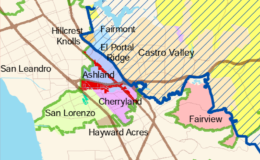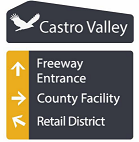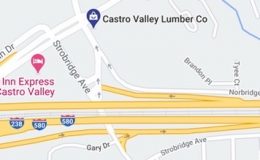Michael,
Thank you for your detailed research into this matter. I would often drive by and wonder what the plan was for that valuable piece of realestate. Visually, the location feels like the epicenter of downtown. It is pregnant with possibilities.
Late to the party
- By : Michael Kusiak
- Category : Economic Development, Governance, Local Control, Town Square
- Tags: redevelopment dissolution
Castro Valley still has a chance to have a say in the fate of the Daughtrey’s building despite coming to the redevelopment dissolution party really, really late.

The first thing you can do to help in tearing down Daughtrey’s and building a town square is to learn a little about a complex phenomenon called “redevelopment” and how the closing of California’s redevelopment agencies is pushing Alameda County to unload the Daughtrey’s building without a guarantee that this concrete and asbestos monolith will be substantially improved when it is handed over to a new owner.
By the end of this post, I hope that you will appreciate how something called a “Long-Range Property Management Plan (LRPMP)” is the key to unlocking the potential of Castro Valley’s downtown.
Redevelopment 101
Prior to 2012, California counties and cities had the authority to declare certain areas “blighted” and in need of redevelopment.
It was through the redevelopment process that in April 2011 Alameda County, through its Redevelopment Agency, purchased the Daughtrey’s building, spending $2,797,000 on a building with known asbestos issues, contaminated water in its basement, and a perplexing inability to find a long-term tenant. According to the Redevelopment Agency’s letter to the Board of Supervisors about the site, “Acquisition of this property will allow the Agency to facilitate the redevelopment of a vacant building along Castro Valley Boulevard that needs physical upgrades and for more than a decade has been underutilized and intermittently leased. The Agency intends to market the site for resale to be rehabilitated and reused as a commercial building.”
Redevelopment agencies were able to create a revenue stream to finance the purchase of properties though the diversion of property taxes in a given “redevelopment area.” The creation of a “redevelopment area” triggered a change in how property taxes were allocated to government agencies, like local school and fire districts, that would normally receive property tax revenue generated in a particular area. Once a designated area became a “redevelopment area”, the government agencies that previously received a portion of the collected property taxes for that area would continue to do so; however, any new revenue above and beyond the amount collected before this redevelopment status would be transferred to the local redevelopment agency.
This figure, produced by the Legislative Analyst’s Office (LAO), provides a great visual of the phenomenon I call “freeze and grow.”
These property tax revenue funded redevelopment agency efforts to buy properties, often by using these revenues as collateral to either rehabilitate blighted property or find a new use for them (like parks or community centers). This ability to exclusively capture this additional property tax in a redevelopment area is how Alameda County came up with the funds to purchase the Daughtrey’s building.
Show me the property taxes
At one point, 12 percent of California property tax revenues were flowing into redevelopment agencies, nearly $5 billion out of $45 billion in property tax revenue. In some counties, redevelopment agencies received up to 25 percent of collected property tax revenue, according to the LAO. When the State faced staggering, muliti-billion dollar deficits a few years ago, this was a lot of revenue not going into the coffers to support essential government services like schools, police and fire services.
The Governor and the Legislature saw the billions of dollars flowing into redevelopment agencies as a critical source of revenue “to protect funding for core public services at the local level“.
In 2011, legislation dissolved the over 400 redevelopment agencies in California, including Alameda County’s, on February 1, 2012 and reallocated the property taxes that would have gone to the redevelopment agencies to the school districts and other “core public services” that had been facing significant cuts. Additionally, the redevelopment agencies would sell off their assets and close shop
Alameda County Redevelopment Agency shuts down and the Successor Agency takes over
When the Alameda County Redevelopment Agency was dissolved, its assets, including the Daughtrey’s building, were transferred to Alameda County’s Successor Agency. The main task of the Successor Agency is to dispose of the properties it inherited. The Successor Agency came with an Oversight Board, established by the Alameda County Board of Supervisors, that includes our Board of Supervisor member Nate Miley, Board of Supervisor Member Wilma Chan, and Castro Valley Unified School District Board of Education member John Barbieri.
The California Department of Finance has been playing a critical role in how the 400 redevelopment agencies wind down their businesses and sell off their assets. It must sign off on how a given successor agency plans to hand over the property tax revenues I discussed above, and it must approve how properties will be disposed of, whether sold off or kept by the county. These charts at the Department of Finance’s website provide a step-by-step guide to this process.
A key component of the redevelopment agency dissolution process is the Department of Finance’s approval of a Long-Range Property Management Plan (LRPMP). Successor agencies must dispose of its properties in the manner described in its approved LRPMP. Based on the LRPMP that the Oversight Board approved on July 3, 2013 and sent to the Department of Finance, the estimated value of the Daughtrey’s building site on January 8, 2013 was $950,000.
The bad news
I reviewed the agendas and minutes from each Oversight Board meeting since its first meeting on April 4, 2012 to figure out what it was exactly that the Alameda County’s Successor Agency and the Oversight Board have been up to and figure out what type of participation there has been from the public.
Based on my review of the minutes, it appears that the Daughtrey’s Building was discussed at three separate meetings: May 1, 2012, June 4, 2012 and July 3, 2013. At the June 2012 and July 2013 meetings, the Oversight Board approved the leases to rent the building to the Spirit Halloween Store for $35,000 per lease.
Critically, the Oversight Board approved the LRPMP for submission to the Department of Finance at its July 2013 meeting. The LRPMP recommended that the Daughtrey’s parcel be transferred to the county to be sold for redevelopment. A “Redevelopment Plan for Eden Area Redevelopment Project” from July 2000 is cited in the LRPMP for determining that the Daughtrey’s site should be redevelop to “Encourage and expand shopping facilities in the Project Area by encouraging the development of new commercial uses and the rehabilitation of existing commercial uses.”
Two observations and one question:
- In the three meetings where the Daughtrey’s site was discussed, there was absolutely no public comment documented in the meeting minutes.
- I have not seen any other minutes from the Oversight Board where public comment was elicited about the contents of the LRPMP.
- Why is the “The Redevelopment Plan for Eden Area Redevelopment Project,” a plan from 2000, being used to define how a parcel in downtown Castro Valley should be developed in 2014?
While I am a little discouraged about civic participation in our town, I am also discouraged about the ease of public participation at these meetings.
Take a look at the July 3, 2013 meeting, when the Oversight Board approved the critical LRPMP. It took place at 1:30 PM in Downtown Oakland, the day before the Independence Day holiday. Many of these Oversight Board meetings have taken place in the middle of the day, all in Downtown Oakland.
I don’t know if it is fair to expect that the average citizen would even know the importance of the decisions being made by the Successor Agency Oversight Board and hop on BART in the middle of a workday to attend a meeting. But, when your docket includes projects from all over Alameda County, why would a reasonable person expect that these meetings would take place in Castro Valley?
The dissolution of redevelopment agencies has been complex enough that the State, successor agencies, and policy makers have struggled to implement it. I get the sense that the folks working in trenches to see the dissolution of redevelopment agencies through the end are pretty burnt out.
But maybe this does point to how both citizens and the county could go a better job of effecting unincorporated community engagement in unincorporated issues…issues that get easily lost in the everyday life of county governance?
The opportunity
As promised, I think there is a way for Castro Valley to change the current designated course for the Daughtrey’s building, resulting in a better outcome that could transform the heart of our community.
I spoke with the Department of Finance on Friday, and as of January 24, 2013, the Alameda County’s LRPMP has not been approved. The Successor Agency is not yet bound to implement the LRPMP. Castro Valley still has a chance to have a say in the fate of Daughtrey’s, despite being late to the redevelopment dissolution party.
The Oversight Board would need to amend the LRPMP so that the Daughtrey’s site is transferred and retained by the county, just like the parcel on Wilbeam, behind Daughtrey’s and the Ice Creamery, that the county plans on developing into a shared parking lot for downtown.
If we show up in force at the February 4, 2014 MAC meeting, and then make our way to Oakland on February 26, 2014 for the planned Successor Agency Oversight Board meeting, we have a fighting chance of amending the LRPMP and building a town square for Castro Valley.
Rememeber, this all comes down to the LRPMP.



